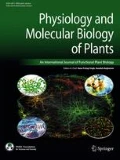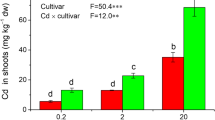Abstract
Chickpea (Cicer arietinum) belonging to the Fabaceae family is a major legume crop and is a good source of protein and carbohydrates. Industrialization has resulted in soil contamination with heavy metals such as cadmium. Adsorption of cadmium by plants can lead to reduced yields and heavy metal toxicity. In the current study, changes in the anatomical, morphological features and biochemical properties of the chickpea plant were evaluated. Two indexes DWSTI and PHSTI were determined. Anatomically, there was a change in the number of xylem poles within the root structure which was most significant at treatments of 125 μg cadmium. There was also a noticeable change in leaf pigmentation, the total phenolics and soluble protein in the plant. Cadmium levels were elevated attaining concentrations of 0.21, 0.40 and 0.52 mg per gram dry weight in plants exposed to 62, 125 and 250 μg/g Perlit cadmium after a period of 30 days. A noticeable increase in the level of cadmium in the plant was observed. Two PCS genes, glutathione gamma-glutamylcysteinyltransferase 1 and glutathione gamma-glutamylcysteinyltransferase and four FC genes, 4 proteins and 4 mRNA were detected in chickpeas. Bioinformatics tools were utilized to predict enzyme structure and binding sites. Chickpea may be classified as a cadmium hyperaccumulator and may be considered for use in phytoremediation. This study provides a better understanding with regards to the response of chickpeas to cadmium and the genetic mechanism by which the plant regulates heavy metal toxicity.
Graphic abstract





Similar content being viewed by others
References
Ali B, Gill RA, Yang S, Gill MB, Farooq MA, Liu D, Daud MK, Ali S, Zhou W (2015) Regulation of cadmium-induced proteomic and metabolic changes by 5-aminolevulinic acid in leaves of Brassica napus L. PLoS ONE 10:e0123328. https://doi.org/10.1371/journal.pone.0123328
Amin H, Arain BA, Amin F, Surhio MA (2014) Analysis of growth response and tolerance index of Glycine max (L.) Merr. under hexavalent chromium stress. Adv Life Sci 1:231–241
Arnot JA, Gobas FAPC (2006) A review of bioconcentration factor (BCF) and bioaccumulation factor (BAF) assessments for organic chemicals in aquatic organisms. Environ Rev 14(4):257–297. https://doi.org/10.1139/a06-005
Baca A, Kornfeind P, Preuschl E, Bichler S, Tampier M, Novatchkov H (2010) A server-based mobile coaching system. Sensors (Basel) 10:10640–10662. https://doi.org/10.3390/s101210640
Bradford MM (1976) A rapid and sensitive method for the quantitation of microgram quantities of protein utilizing the principle of protein-dye binding. Anal Biochem 72:248–254. https://doi.org/10.1016/0003-2697(76)90527-3
Bryan JHD (1955) Differential staining with a mixture of safranin and fast green FCF. Stain Technol 30(4):153–157. https://doi.org/10.3109/10520295509114456
Bundy JG, Kille P (2014) Metabolites and metals in Metazoa—What role do phytochelatins play in animals? Metallomics 6:1576–1582. https://doi.org/10.1039/C4MT00078A
Chou KC, Shen HB (2010) Plant-mPLoc: a top-down strategy to augment the power for predicting plant protein subcellular localization. PLoS ONE 5:e11335–e11335. https://doi.org/10.1371/journal.pone.0011335
Chubukova OV, Postrigan BN, Andrei B, Chemeris A (2015) The effect of cadmium on the efficiency of development of legume-rhizobium symbiosis. Biol Bull 42:458–462. https://doi.org/10.1134/S1062359015050040
Costa G, Spitz E (1997) Influence of cadmium on soluble carbohydrates, free amino acids, protein content of in vitro cultured Lupinus albus. Plant Sci 128:131–140. https://doi.org/10.1016/S0168-9452(97)00148-9
Engel DE, DeGrado WF (2004) Amino acid propensities are position-dependent throughout the length of α-helices. J Mol Biol 337:1195–1205. https://doi.org/10.1016/j.jmb.2004.02.004
Ericson MC, Alfinito SH (1984) Proteins produced during salt stress in tobacco cell culture. Plant Physiol 74:506–509. https://doi.org/10.1104/pp.74.3.506
Espinas NA, Kobayashi K, Sato Y, Mochizuki N, Takahashi K, Tanaka R, Masuda T (2016) Allocation of heme Is differentially regulated by ferrochelatase isoforms in Arabidopsis cells. Front Plant Sci 7:1326. https://doi.org/10.3389/fpls.2016.01326
Godinho DP, Serrano HC, Da Silva AB, Branquinho C, Magalhaes S (2018) Effect of cadmium accumulation on the performance of plants and of herbivores that cope differently with organic defenses. Front Plant Sci 9:1723. https://doi.org/10.3389/fpls.2018.01723
Goldberg T, Hecht M, Hamp T, Karl T, Yachdav G, Ahmed N, Altermann U, Angerer P, Ansorge S, Balasz K, Bernhofer M, Betz A, Cizmadija L, Do KT, Gerke J, Greil R, Joerdens V, Hastreiter M, Hembach K, Herzog M, Kalemanov M, Kluge M, Meier A, Nasir H, Neumaier U, Prade V, Reeb J, Sorokoumov A, Troshani I, Vorberg S, Waldraff S, Zierer J, Nielsen H, Rost B (2014) LocTree3 prediction of localization. Nucleic Acids Res. https://doi.org/10.1093/nar/gku396
Goodwin RG, Kell WJ, Laidler P, Long CC, Whatley SD, McKinley M, Badminton MN, Burnett AK, Williams GT, Elder GH (2006) Photosensitivity and acute liver injury in myeloproliferative disorder secondary to late-onset protoporphyria caused by deletion of a ferrochelatase gene in hematopoietic cells. Blood 107:60–62. https://doi.org/10.1182/blood-2004-12-4939
Khor BY, Tye GJ, Lim TS, Choong YS (2015) General overview on structure prediction of twilight-zone proteins. Theor Biol Med Model 12:15. https://doi.org/10.1186/s12976-015-0014-1
Kim J, Keyes T, Straub JE (2009) Replica exchange statistical temperature Monte Carlo. J Chem Phys 130:124112. https://doi.org/10.1063/1.3095422
Lamien-Meda A, Lamien CE, Romito M, Millogo J, Nacoulma OG (2005) Determination of the total phenolic, flavonoid and proline contents in Burkina Fasan honey, as well as their radical scavenging activity. Food Chem 91:571–577. https://doi.org/10.1016/j.foodchem.2004.10.006
Li J, Guo J, Xu W, Ma M (2006) Enhanced cadmium accumulation in transgenic tobacco expressing the phytochelatin synthase gene of Cynodon dactylon L. J Integr Plant Biol 48:928–937. https://doi.org/10.1111/j.1744-7909.2006.00314.x
Li G, Peng X, Xuan H, Wei L, Yang Y, Guo T, Kang G (2013) Proteomic analysis of leaves and roots of common wheat (Triticum aestivum L.) under copper-stress conditions. J Proteome Res 12:4846–4861. https://doi.org/10.1021/pr4008283
Li C, Yang X, Xu Y, Li L, Wang Y (2018) Cadmium detoxification induced by salt stress improves cadmium tolerance of multi-stress-tolerant Pichia kudriavzevii. Environ Pollut 242:845–854. https://doi.org/10.1016/j.envpol.2018.07.058
Lichtenthaler HKBTM (1987) Chlorophylls and carotenoids: pigments of photosynthetic biomembranes. Plant cell membranes. Academic Press, Cambridge, pp 350–382. https://doi.org/10.1016/0076-6879(87)48036-1
Liu L, Zhang Q, Hu L, Tang J, Xu L, Yang X, Yong JWH, Chen X (2012) Legumes can increase cadmium contamination in neighboring crops. PLoS ONE 7:e42944–e42944. https://doi.org/10.1371/journal.pone.0042944
Lone MI, He Z, Stoffella PJ, Yang X (2008) Phytoremediation of heavy metal polluted soils and water: progresses and perspectives. J Zhejiang Univ Sci B 9:210–220. https://doi.org/10.1631/jzus.B0710633
Lux A, Šottníková A, Opatrná J, Greger M (2004) Differences in structure of adventitious roots in Salix clones with contrasting characteristics of cadmium accumulation and sensitivity. Physiol Plant 120:537–545. https://doi.org/10.1111/j.0031-9317.2004.0275.x
Manquián-Cerda K, Cruces E, Escudey M, Zúñiga G, Calderón R (2018) Interactive effects of aluminum and cadmium on phenolic compounds, antioxidant enzyme activity and oxidative stress in blueberry (Vaccinium corymbosum L.) plantlets cultivated in vitro. Ecotoxicol Environ Saf 150:320–326. https://doi.org/10.1016/j.ecoenv.2017.12.050
Masuda T, Suzuki T, Shimada H, Ohta H, Takamiya K (2003) Subcellular localization of two types of ferrochelatase in cucumber. Planta 217:602–609. https://doi.org/10.1007/s00425-003-1019-2
Nielsen H, Almagro Armenteros JJ, Sønderby CK, Sønderby SK, Winther O (2017) DeepLoc: prediction of protein subcellular localization using deep learning. Bioinformatics 33:3387–3395. https://doi.org/10.1093/bioinformatics/btx431
Nishizawa ION, Satoshi MK (2009) Time course analysis of gene regulation under cadmium stress in rice. Plant Soil 325:97–108. https://doi.org/10.1007/s11104-009-0116-9
Oborník M, Green BR (2005) Mosaic origin of the heme biosynthesis pathway in photosynthetic eukaryotes. Mol Biol Evol 22:2343–2353. https://doi.org/10.1093/molbev/msi230
Pandit SB, Zhang Y, Skolnick J (2006) TASSER-Lite: an automated tool for protein comparative modeling. Biophys J 91:4180–4190. https://doi.org/10.1529/biophysj.106.084293
Paul PJ, Samineni S, Thudi M, Sajja SB, Rathore A, Das RR, Khan AW, Chaturvedi SK, Lavanya GR, Varshney RK, Gaur PM (2018) Molecular mapping of QTLs for heat tolerance in chickpea. Int J Mol Sci 19:2166. https://doi.org/10.3390/ijms19082166
Picault N, Cazale AC, Beyly A, Cuiné S, Carrier P, Luu DT, Forestier C, Peltier G (2006) Chloroplast targeting of phytochelatin synthase in Arabidopsis: effects on heavy metal tolerance and accumulation. Biochimie 88(11):1743–1750. https://doi.org/10.1016/j.biochi.2006.04.016
Rivera-Becerril F, Calantzis C, Turnau K, Caussanel JP, Belimov AA, Gianinazzi S, Strasser RJ, Gianinazzi-Pearson V (2002) Cadmium accumulation and buffering of cadmium-induced stress by arbuscular mycorrhiza in three Pisum sativum L. genotypes. J Exp Bot 53:1177–1185. https://doi.org/10.1093/jexbot/53.371.1177
Romero-Puertas MC, Palma JM, Gómez M, Del Río LA, Sandalio LM (2002) Cadmium causes the oxidative modification of proteins in pea plants. Plant Cell Environ 25:677–686. https://doi.org/10.1046/j.1365-3040.2002.00850.x
Sharma P, Dubey RS (2005) Lead toxicity in plants. Braz J Plant Physiol 17(1):35–52. https://doi.org/10.1590/S1677-04202005000100004
Sharma M, Laxmi A (2016) Jasmonates: emerging players in controlling temperature stress tolerance. Front Plant Sci 6:1129. https://doi.org/10.3389/fpls.2015.01129
Singh R, Gautam N, Mishra A, Gupta R (2011) Heavy metals and living systems: an overview. Indian J Pharmacol 43:246–253. https://doi.org/10.4103/0253-7613.81505
Sjödin S, Öhrfelt A, Brinkmalm G, Zetterberg H, Blennow K, Brinkmalm A (2016) Targeting LAMP2 in human cerebrospinal fluid with a combination of immunopurification and high resolution parallel reaction monitoring mass spectrometry. Clin Proteomics 13:4. https://doi.org/10.1186/s12014-016-9104-2
Song J, Feng SJ, Chen J, Zhao WT, Yang ZM (2017) A cadmium stress-responsive gene AtFC1 confers plant tolerance to cadmium toxicity. BMC Plant Biol 17:187. https://doi.org/10.1186/s12870-017-1141-0
Veno J, Rahman RNZRA, Masomian M, Ali MSM, Kamarudin NHA (2019) Insight into improved thermostability of cold-adapted Staphylococcal lipase by glycine to cysteine mutation. Molecules 24(17):3169. https://doi.org/10.3390/molecules24173169
Wallace TC, Murray R, Zelman KM (2016) The nutritional value and health benefits of chickpeas and hummus. Nutrients 8:766. https://doi.org/10.3390/nu8120766
Woodson JD, Perez-Ruiz JM, Chory J (2011) Heme synthesis by plastid Ferrochelatase I regulates nuclear gene expression in plants. Curr Biol 21:897–903. https://doi.org/10.1016/j.cub.2011.04.004
Yamazaki S, Ueda Y, Mukai A, Ochiai K, Matoh T (2018) Rice phytochelatin synthases OsPCS1 and OsPCS2 make different contributions to cadmium and arsenic tolerance. Plant Direct 2:e00034. https://doi.org/10.1002/pld3.34
Yang AM, Cheng ZY, Pu HQ, Cheng N, Li HY, Liu SM, Ding J, Li JS, Hu XB, Ren XW, Zheng TZ, Bai YN (2017) Heavy metal assessment among Chinese nonferrous metal-exposed workers from the Jinchang cohort study. Biomed Environ Sci 30:530–534
Yoshida A, Hagiwara S, Watanabe T, Nishida N, Ida H, Sakurai T, Komeda Y, Yamao K, Takenaka M, Enoki E, Kimura M, Miyake M, Kawada A, Kudo M (2018) Erythropoietic protoporphyria-related hepatopathy successfully treated with phlebotomy. Intern Med 57:2505–2509. https://doi.org/10.2169/internalmedicine.0673-17
Zhao WT, Feng SJ, Li H, Faust F, Kleine T, Li LN, Yang ZM (2017) Salt stress-induced Ferrochelatase 1 improves resistance to salt stress by limiting sodium accumulation in Arabidopsis thaliana. Sci Rep 7:14737. https://doi.org/10.1038/s41598-017-13593-9
Acknowledgements
This work was funded by a grant from the Shahid Chamran University of Ahvaz Research Council and Tabriz University Research Council. Last but not least, an emotional, heartfelt thank you to my late uncle Dr. Reza Oboodi for his unending support and guidance to the author (Dr. Maryam Kolahi). I hope he is somehow watching this from somewhere with a satisfactory smile.
Funding
Not applicable’ for that section.
Author information
Authors and Affiliations
Corresponding author
Ethics declarations
Conflict of interest
The authors report no declarations of interest and that they are responsible for the content and writing of the article.
Additional information
Publisher's Note
Springer Nature remains neutral with regard to jurisdictional claims in published maps and institutional affiliations.
Appendix
Appendix
See Table 4.
Rights and permissions
About this article
Cite this article
Mohajel Kazemi, E., Kolahi, M., Yazdi, M. et al. Anatomic features, tolerance index, secondary metabolites and protein content of chickpea (Cicer arietinum) seedlings under cadmium induction and identification of PCS and FC genes. Physiol Mol Biol Plants 26, 1551–1568 (2020). https://doi.org/10.1007/s12298-020-00804-3
Received:
Revised:
Accepted:
Published:
Issue Date:
DOI: https://doi.org/10.1007/s12298-020-00804-3




